Maybe because January is one of the longest winter months here in Maine, we thought we would shed some light and generate some energy with this Dispatch, which just so happens to mark the one-year anniversary of our monthly newsletters. For this issue, we talked to designers, engineers, and sources about determining the best lighting for your boat, and then we follow it up with a study of how to generate enough power for all of those fixtures and devices. As always, please keep your feedback and story ideas coming by sending us an email or giving us a call.
In this January Dispatches:
Light Your Ride: Illumination 101
Light Your Ride: Illumination 101
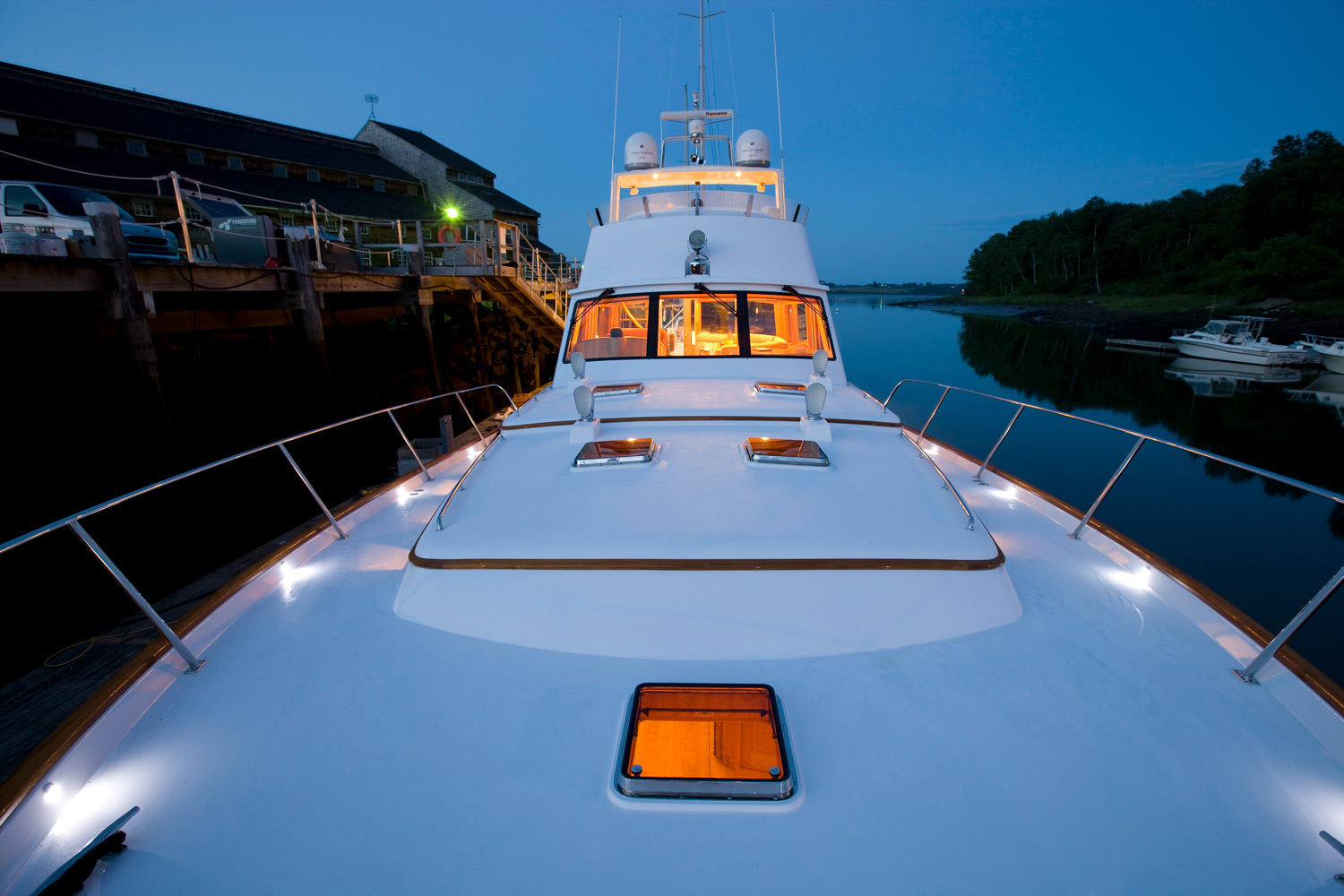 Lighting sets the stage. A new generation of low-cost, low-power, weather-proof marine light fixtures and control devices is bathing decks, cabins and even hidden lockers, in beautiful movie-set quality lighting.
Lighting sets the stage. A new generation of low-cost, low-power, weather-proof marine light fixtures and control devices is bathing decks, cabins and even hidden lockers, in beautiful movie-set quality lighting.
“Lighting has evolved into one of the highest priorities of our clients,” says Doug Zurn, of Zurn Yacht Design, the Marblehead, Massachusetts-based marine design and engineering firm. “It’s right up there with performance and timeless good looks.”
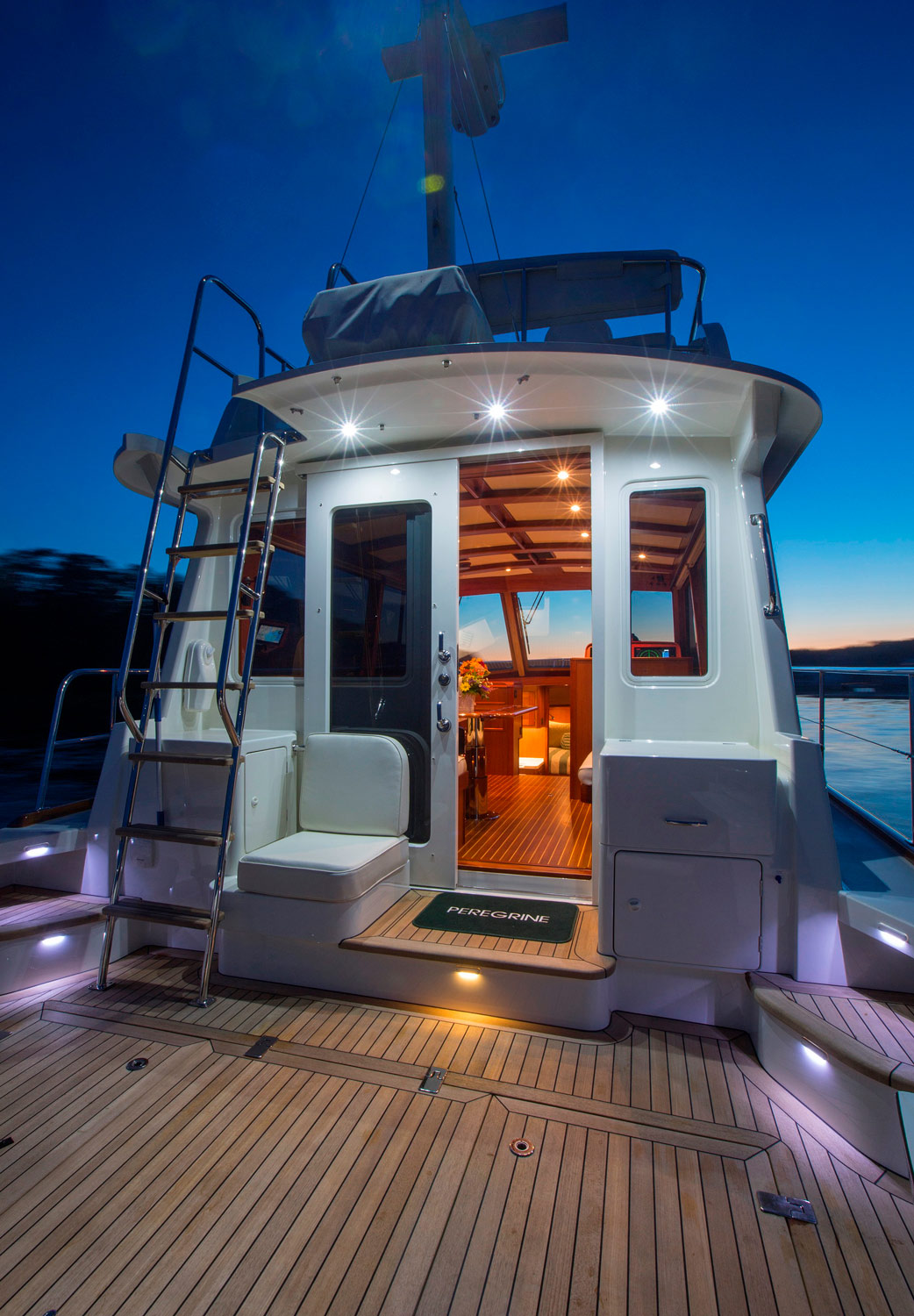 In fact, navigation lights, deck floodlights, cockpit courtesy lights, submersible lights, interior accent lights and even those for stand-up paddleboards have led to a four-fold increase in the number fixtures found onboard. It is now common for a vessel, like the Lyman-Morse Hood 57, the 67-foot Lyman-Morse power cruiser Mad Max, or the 65-foot daysailer Anna to have more than 75 fixtures distributed throughout the vessel.
In fact, navigation lights, deck floodlights, cockpit courtesy lights, submersible lights, interior accent lights and even those for stand-up paddleboards have led to a four-fold increase in the number fixtures found onboard. It is now common for a vessel, like the Lyman-Morse Hood 57, the 67-foot Lyman-Morse power cruiser Mad Max, or the 65-foot daysailer Anna to have more than 75 fixtures distributed throughout the vessel.
That’s dramatically more lights per-foot than the average home.
LED: Lighting Letters That Matter
The history of lights afloat follows the history of lights on land: Tallow, wax, and animal fuels powered navigation and deck lighting into the 19th century. Fossil fuels and incandescent bulbs lit boats into the 20th. But today, it is light emitting diodes, or LEDs, that illuminate most vessels.
LEDs are cheaper and more durable than standard fixtures. They don’t rely on thin electrically charged metallic filaments to make light. Instead, LEDs glow by fooling electrons into hopping gracefully across small chemical imbalances engineered into the molecular surface of a family of semiconductors called diodes. When diodes are tied to drivers, transformers, and control networks, they can emit light in all the possible colors of the rainbow with minimal lost heat. Marine LEDs are simply fixtures made to be impervious to the wind, dust, and water.
“LEDs have absolutely transformed the expectations of what can be seen and done onboard a boat,” says Kinder Woodcock, northeast sales manager for Imtra, the New Bedford, Massachusetts-based marine parts wholesaler, who has sold and serviced marine lighting for decades. “Customers now expect full functionality in all areas of a boat. From the engine room, to the cockpit, and into the head.”
Nothing But LEDs
Analysts expect the market for near-magical light emitting diodes to grow by a blistering 11 percent annually through the next decade. Innovation is expected to start in Europe, then flow to the American market.
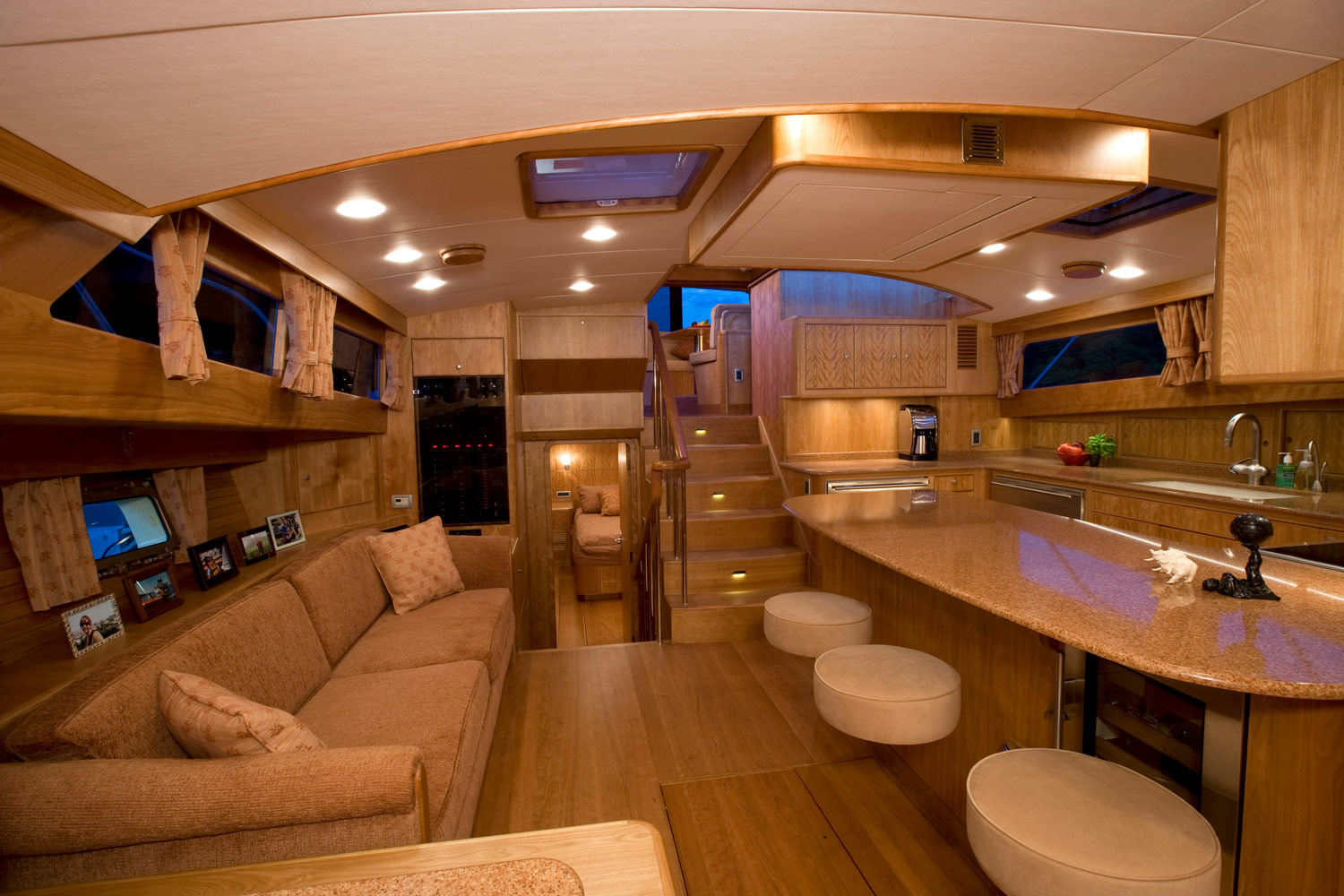 But LED’s exciting growth has introduced some new players and is changing how light layouts are discussed and specified. Established marine lighting makers like Aspect LED and Hella Marine are facing upstarts like Black Oak and Dr. LED. Both are offering interactive online resources to drive sales. Lumishore’s submersible lighting configurator, Hella Marine’s Lighting Designer app, and a new generation of lighting previsualization tools open up and make the conversations between boat designers, owners, and builders easier.
But LED’s exciting growth has introduced some new players and is changing how light layouts are discussed and specified. Established marine lighting makers like Aspect LED and Hella Marine are facing upstarts like Black Oak and Dr. LED. Both are offering interactive online resources to drive sales. Lumishore’s submersible lighting configurator, Hella Marine’s Lighting Designer app, and a new generation of lighting previsualization tools open up and make the conversations between boat designers, owners, and builders easier.
“Internally we make sure the lighting layout is balanced in the interior overhead panels and that they are placed appropriately for the obvious task,” says Lance Buchanan, a project manager at Lyman-Morse who managed lighting for new builds like Mad Max, Peregrine and new Lyman-Morse Hood 57.
Builders caution that without careful oversight LEDs can cause issues: Poorly installed LEDs can cause radio interference; they can carry a directional polarity that reduces effectiveness. There is also a growing set of international regulations and U.S. Coast Guard rules that make lighting more complex. Some harbors are even banning some lighting, particularly for fishing.
Light without Lamps
The LED wave on boats is only beginning to break: LEDs can glow more golden as they dim to emulate traditional lamps. Smartphones now remotely control lights. Ultrathin and flexible OLED lighting will make many fixtures disappear. Boats are emerging as ideal platforms for sustainable lighting by harnessing ambient light, through the emerging science of spatial lighting autonomy. (Perhaps, a topic for another day.)
Fairly soon, the best-lit boats may be notable for having no noticeable lighting fixtures at all.
Genny Up to Power Up
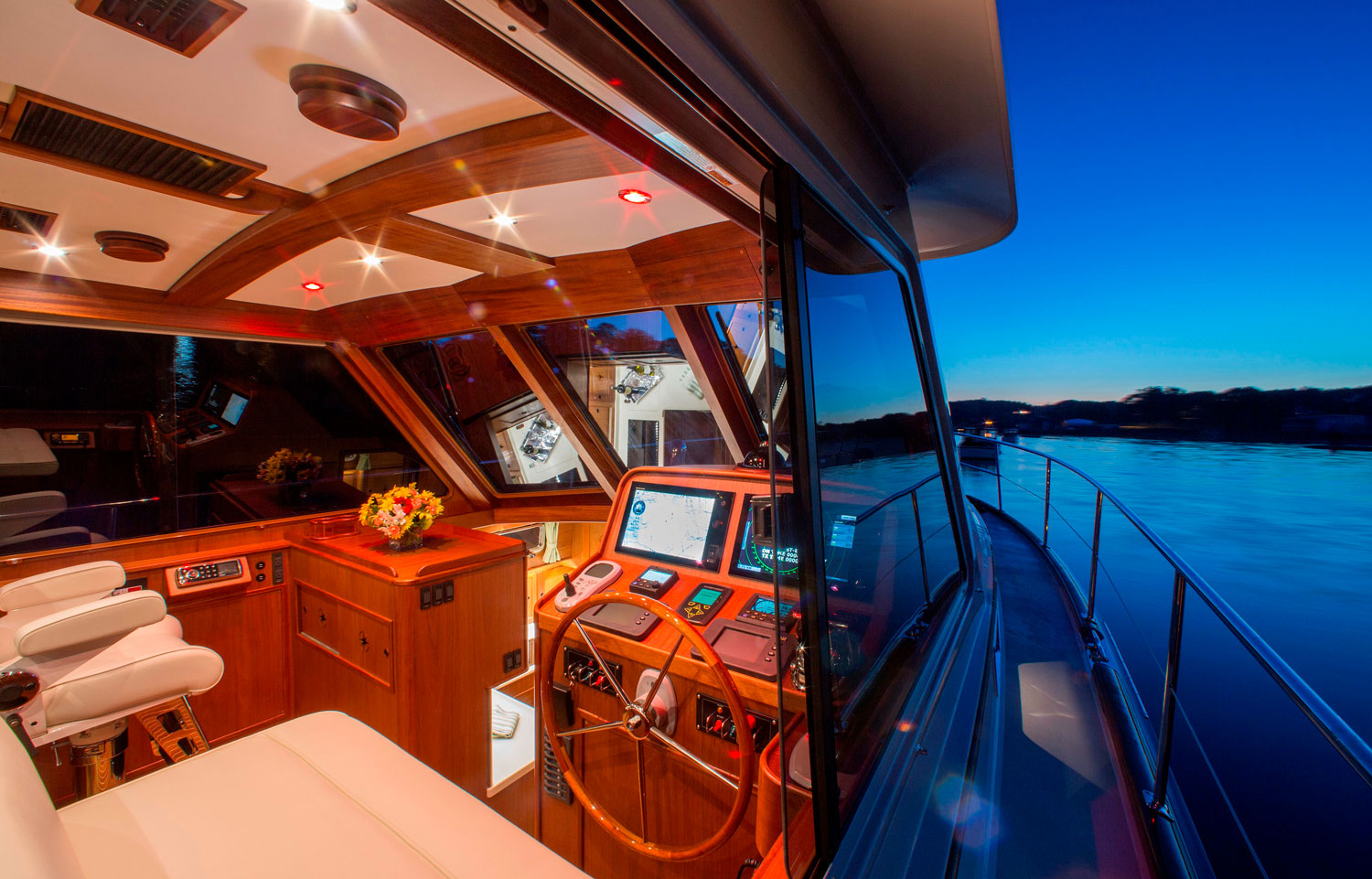 Boats used to be so simple. The engine powered the boat. Its pistons turned the propeller. Its alternator charged the batteries and ran the radio, running lights, and some low-key interior lighting. The engine warmed water, albeit to tepidness.
Boats used to be so simple. The engine powered the boat. Its pistons turned the propeller. Its alternator charged the batteries and ran the radio, running lights, and some low-key interior lighting. The engine warmed water, albeit to tepidness.
No more. Today’s vessels are worlds unto themselves chock full of lights (see Light Your Ride), electronics, entertainment features, gyroscopic motion control, retractable awnings, and sophisticated climate control systems. All need power — and a powerful marine generator — to keep them running at a swipe of a finger. Estimates say that marine generators see 3 to 5 times more use than a vessel’s core propulsion engine.
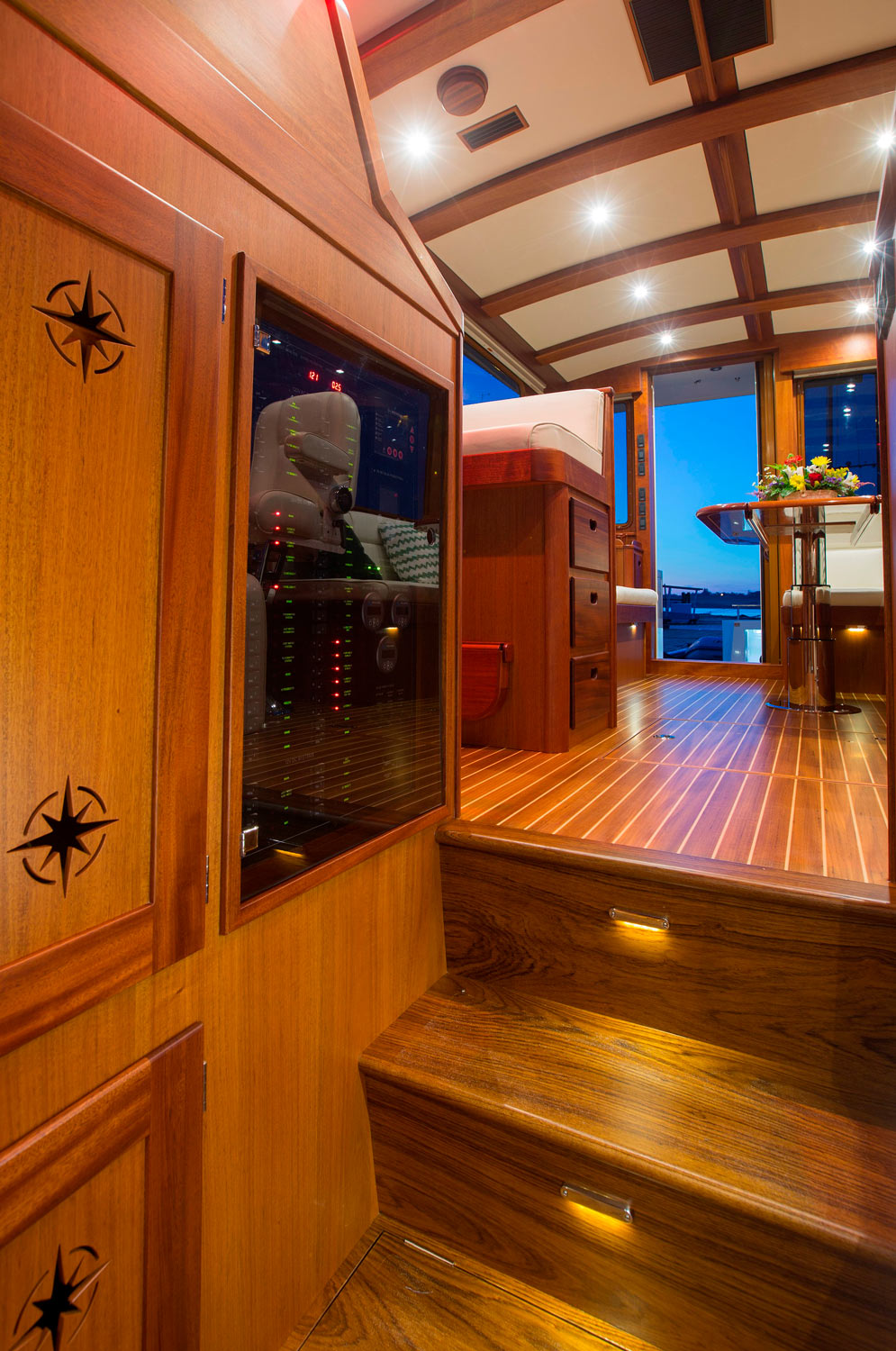 Demand for sophisticated marine powerplants is among the most common requests at Lyman-Morse. New builds like the Lyman-Morse Hood 57, Anna, and Peregrine featured sophisticated generation, as did refits like Red Sky and Scout.
Demand for sophisticated marine powerplants is among the most common requests at Lyman-Morse. New builds like the Lyman-Morse Hood 57, Anna, and Peregrine featured sophisticated generation, as did refits like Red Sky and Scout.
Tailoring modern marine generators to a particular boat has evolved into a complex team sport between power engineers, project managers, and installers. “It all comes down to taking the time to walk through a proper install,” says Chaz Guthrie, mechanical supervisor at Lyman-Morse, who’s been involved in generator installations for the past five years.
“To get there, we start with a good engineering plan and process. Then it’s just about getting the details right.”
How Big Is Big Enough?
The devil-in-the-details for a proper generator installation starts with listing the power demands of all the appliances, navigation aids, and climate control systems on a boat. Genset makers like Cummins offer excellent online load calculation resources. But such tools often fail to factor in the dynamic loads of which devices are running at a given time. So, it falls to Lyman-Morse’s project managers to work with boat captains and/or owners to accurately predict a vessel’s true power demands.
Allowances must be made for the ten- to twenty-fold spike in power demand that can be caused by the so-called in-rush current that surges through an electric motor as it starts. Such spike loads can be mitigated by so-called soft start technologies. Regardless, spike loads should never strain generators, which should never run at less than 25 percent, or more than 80 percent, of total capacity.
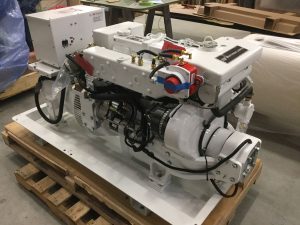 To break in generators for proper services, Lyman-Morse’s power systems engineers, including Toby Teele, are careful to run new generators at manageable loads for roughly 50 hours to break them in. Smaller units, usually measured in electrical kilowatts, or eKW, save fuel and weight. So Teele often supplements generator energy needs with inverters. He is also testing emerging auxiliary power system like Intregral that siphon and store power from a boat’s propulsion engines. Power can also be cached in a new family of carbon foam or lithium-ion batteries. Sophisticated Process Logic Controllers (PLCs) can also be installed to turn off systems, shed load, and protect generators.
To break in generators for proper services, Lyman-Morse’s power systems engineers, including Toby Teele, are careful to run new generators at manageable loads for roughly 50 hours to break them in. Smaller units, usually measured in electrical kilowatts, or eKW, save fuel and weight. So Teele often supplements generator energy needs with inverters. He is also testing emerging auxiliary power system like Intregral that siphon and store power from a boat’s propulsion engines. Power can also be cached in a new family of carbon foam or lithium-ion batteries. Sophisticated Process Logic Controllers (PLCs) can also be installed to turn off systems, shed load, and protect generators.
Installing A Good Genny
Next is positioning the generator, ventilation, and exhaust. Usually, generators share enclosures with propulsion engines. Engine rooms must be well-ventilated, close to fuel supplies and electrical networks. They must meet an ever-expanding roster of emission regulations . Ventilation must be optimized for the size of the engine, its operating speeds, and the volumetric efficiency of the air-fuel mixture entering the engine block.
 Raw cooling water must pass properly into through-hulls. Exhaust lines are often fitted with anti-siphon devices. Fuel lines must be properly sized, filtered, and installed to meet standards. Fuel temperature must be kept low enough to combust properly and maintain generator efficiency. Below-surface exhaust systems must also be carefully engineered to prevent flooding: A half-inch rise per foot of exhaust line is required, with a minimum step-up of 12 inches between the engine exhaust elbow and the water muffler.
Raw cooling water must pass properly into through-hulls. Exhaust lines are often fitted with anti-siphon devices. Fuel lines must be properly sized, filtered, and installed to meet standards. Fuel temperature must be kept low enough to combust properly and maintain generator efficiency. Below-surface exhaust systems must also be carefully engineered to prevent flooding: A half-inch rise per foot of exhaust line is required, with a minimum step-up of 12 inches between the engine exhaust elbow and the water muffler.
Electrical installation is also a key. All connectors must be properly shielded and grounded. Motion is a fact of life underway; a poorly insulated electrical connection can abrade and cause a fire.
Mounts also matter. A rock-solid generator mounting tray must be securely bolted to a sound shield pan, that is in turn soft-mounted to hull structures beefy enough to prevent generators from rocking in rough seas. Larger systems require up to a three-inch clearance. A generator can never touch a pipe or wall fitting, or it can make a terrible racket, or do terrible damage. All this and more must be done to the highest possible standards.
Ironically, Guthrie says that the key to the most complex power-generation setup is keeping the installation simple. “It all comes down to doing a simple installation,” he says. “When the plan is right, it’s easy to follow the specifications. The systems just fit together, and you just know it’s going to work.”
Want to make sure you don’t miss next month’s Dispatches? Click Here to have them sent directly to your inbox.
